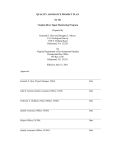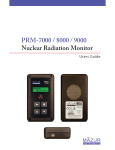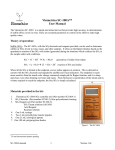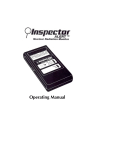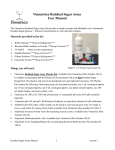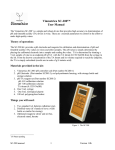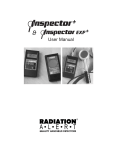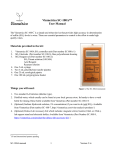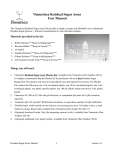Download Dissolved Oxygen Electrode Manual
Transcript
Vinmetrica Dissolved Oxygen System User Manual The Vinmetrica dissolved Oxygen system provides a simple, accurate and affordable way to determine oxygen concentrations in wine and other samples. Materials provided in the kit: 1. Electrolyte Solution 2. Sodium sulfite powder (for 0% Oxygen reference ) 3. Vinmetrica Dissolved Oxygen (DO) probe 4. Standard measuring vial 5. One 5 mL syringe 6. Extra DO probe membrane Figure 1. The Dissolved Oxygen Kit Things you will need: 1. Vinmetrica SC-200 or SC-300, or comparable meter with 1 mV or 0.02 pH resolution. 2. Distilled water (DI water), which usually can be found at your local grocery store. It’s handy to have a wash bottle for rinsing. Rinse bottle available from Vinmetrica (Part number SC-100-17) 3. Small measuring spoon or spatula (e.g., Vinmetrica 0.05 g spoon part#RS-12) Why Test for Dissolved Oxygen? Dissolved oxygen (DO) has numerous effects on wine, some desirable, some definitely not. Depending on the type of wine and its characteristics, controlled exposure to oxygen plays a beneficial role in wine quality such as influencing color stability and suppleness. However, too much oxygen exposure can lead to premature deterioration, browning, and acetaldehyde formation. At time of bottling, for example, it is generally desirable to keep DO below 10% saturation. DO can then be measured throughout the bottling process to ensure oxygen uptake is no more than 1%. Careful management of DO will ensure best stability and outcome for your wine. How it works: The electrode has an internal electrolyte solution behind a gas-permeable membrane. Oxygen in the sample diffuses into this internal electrolyte and creates an electrochemical reaction at the metal contact on the electrode. This is picked up by the SC-200 or -300 and displayed as a voltage reading (firmware x.1.2 or higher), or as an apparent “pH” value, either of which can be related to the response of known oxygen content, allowing you to determine DO as % saturation. Dissolved Oxygen Manual 1 version 1.1 Setup 1. 2. 3. 4. Electrode preparation: for a new electrode’s first use, remove the cap from the electrode by gently unscrewing the end (“membrane end”) of the electrode from the barrel exposing the anode. NOTE: Do not pull off the cap, this may damage the membrane. Using the 5 mL syringe, fill the membrane end with the electrolyte solution. Caution: this solution contains sodium hydroxide (lye). Use gloves and wear eye protection when handling the electrolyte solution. In the event of a spill, add equal volume of baking soda to neutralize, then wash with water. If contact with skin or eyes occurs, flush affected part with plenty of water. Carefully screw on the membrane end back to the bottom of the electrode body, avoiding trapping of air bubbles. Attach the electrode to the pH meter and put it in pH mode or, if available, potential mode (Firmware versions x.1.2 or higher, where x is 2 or 3) a. To use potential mode on a SC-200 or 300 turn instrument on and select pH mode, hit Mode button one more time. The pH LED should now be blinking to indicate potential mode. Procedures 1. 2. Calibration: To calibrate the response of your electrode and instrument, you will determine the values for “0% saturation” (i.e., when no oxygen is present in solution) and for “100% saturation” (i.e., when the maximum amount of oxygen is present). a. Calibrate 0% saturated DO: place about 2 mL of water into the measuring vial (about 2/3 full) and add about 0.75 g (about ¼ teaspoon) of sodium sulfite powder. Swirl for 30 seconds to mix. There should be enough sodium sulfite that solid particles are visible, ie. not all solids will dissolve. This is a saturated solution and it removes all the oxygen from the water. Place the electrode in the vial. Keep the solution moving by gently rotating or swirling the vial. Wait for the value to stabilize, about 1-3 minutes. In potential mode, you should see a value of 0 ± 13 mV or so. If you are reading apparent pH, you will see a value of around 6.5-7.0, depending on the previous pH calibration settings. Write down the value that you see. b. Calibrate 100% saturated DO: remove the electrode and rinse it thoroughly with distilled water; gently shake off excess liquid. Allow air to freely contact the membrane. This will make the electrode display its 100% saturated DO value. Wait for the value to stabilize, again about 1 minute. In potential mode, you should see a value of 300 mV or so. If you are reading apparent pH, you will see a value of around 1.5, depending on the previous pH calibration settings. Write down the value that you see. Rinse out the measurement vial and shake out excess water. Rinse electrode thoroughly with DI water. Dissolved Oxygen Manual 2 version 1.1 3. 4. 5. Measure the wine by either method (a.) or (b.) below. Method (a.) avoids contact with your bulk wine, but is inherently difficult to get highest accuracy because atmospheric oxygen rapidly enters the sample. Method (b.) largely escapes this problem but note the CAUTION statement. a. Take a sample of the wine to be measured. It is important to move quickly to avoid oxygen in the air from reaching the wine sample. (NOTE: if available, use inert gas to sparge the sampling area and the measuring vial to minimize entry of atmospheric oxygen) Place about 2 mL of your wine into the measuring vial (about 2/3 full). Immerse the electrode in the wine sample as in step 1 and slowly swirl the sample. OR b. Insert the clean electrode directly into the wine sample (bottle, carboy, barrel, etc.) and gently swirl. In this case you may want to clean the electrode by dipping it in 20% ethanol solution to minimize contamination of your wine samples. Minimize access of air during this time (sparge the head space with inert gas if possible). [CAUTION: there is a small risk of affecting your wine by this method. Normally the electrolyte solution will not contact your wine, and vice versa, because the membrane is impermeable. However in the event of a leakage due to breakage or detachment of the membrane end of the electrode, a small amount of sodium hydroxide and propylene glycol can enter your wine. The amounts are small enough that a bottle or larger size container of wine will not become unsafe to consume, but be aware of the possibility.] Again wait for the reading to stabilize. Usually the millivolt value will drop to a lower reading over about 1 minute, from which it may slowly start to rise again. Note the lowest reading that you see during this time. If you are reading in pH mode, you will see the opposite effect - a low pH reading will rise, then possibly start to decrease again - take the highest value. Again wait for the reading to stabilize. Usually the millivolt value will drop to a lower reading over about 1 minute, from which it may slowly start to rise again. Note the lowest reading that you see during this time. If you are reading in pH mode, you will see the opposite effect - a low pH reading will rise, then possibly start to decrease again - take the highest value. Table 1 shows some typical data: Table 1. typical data in mV or pH mode (Note: your data may be different!) Test mV “pH” 0% DO +8.0 6.67 100% DO +302 1.48 Wine sample +50 5.92 6. Calculate DO as % of saturation as follows: Subtract the 0% DO calibration value from each reading. Divide the subtracted value for each wine sample by the subtracted value for the 100% Saturated DO calibration value. Multiply this by 100 to get percent saturated DO for each wine sample, i.e. Dissolved Oxygen Manual 3 version 1.1 DO, % saturation = 100 * [Wine sample – 0% DO]/[100% DO - 0% DO] For example, from the data in Table 1: DO, % saturation = 100 * (50-8.0)/(302-8.0) = 14% Or = 100 *(5.92-6.67)/(1.48-6.67) = 14%. Reporting dissolved oxygen in mg/L : If you prefer to get your data in units of mg/L of dissolved oxygen, you can convert your % saturation values. You need to know what value of mg/L DO corresponds to 100% saturation DO. This number depends on several factors, including the conductivity (or “salinity”) of the wine, its alcohol content, temperature, and the ambient barometric pressure. For most wines, only the latter two are significant. At room temperature (72 F or 22.5 degrees C) and ordinary air pressure (sea level on a clear day), the saturating oxygen level is about 8.5 mg/L. For most purposes, this value will be close enough to give you the accuracy needed to make decisions. Be aware, however that this value decreases about 10% for every 5ºC (8ºF) increase and for every 3000 feet (1000m) of elevation increase.1 Once you have a value for 100% (saturating) dissolved oxygen for your wine in ambient conditions, calculate your dissolved oxygen from the data you have. DO, mg/L = saturating oxygen level (mg/L) x % saturation In the above example, assuming we are at sea level and 72 degrees, the DO is 8.5 x 14% = 1.2 mg/L Finishing Up: 1. Turn off your pH meter and rinse the vials and the electrode with DI water. 2. Electrode Storage: The electrode may be stored filled with solution, but make sure the electrode is disconnected from the meter during storage. For long term storage you should store the electrode dry (drain the fill solution out and rinse with distilled water). 3. Cleaning and Maintenance: After the electrode has been used for a period of time the residual current may rise, which shows up as an increasing value of 0% DO. To minimize the residual current, the following cleaning method is recommended. Gently unscrew the bottom membrane cap from the electrode body and rinse the inside of the membrane with DI water. Soak the metal anode in 0.1N HCl (8.3 ml concentrated HCl in 1000 ml DI water, or 1 mL Vinmetrica Acid Solution in 20 mL water) for 15 to 20 minutes. Rinse the metal anode with DI 1 To estimate changes in saturating dO2 with temperature and pressure, see the dissolved oxygen calculator at http://water.usgs.gov/software/DOTABLES/ . Set the specific conductivity of the wine to 3000 microsieverts/cm. To calculate air pressure change with altitude, see http://www.altitude.org/air_pressure.php Dissolved Oxygen Manual 4 version 1.1 water, blot dry with tissue paper. Refill the electrode with electrolyte and replace membrane cap as directed in the electrode instructions. 4. Replacing the membrane: The membrane that comes in the probe has a life expectancy of one year. However the membrane may become damaged and will need replacing. Your kit provides one extra of these membranes. To replace membrane unscrew the electrode cap. You will then pull off the tip of the cap. Remove old or damaged membrane. As gently as possible remove new membrane from paper by gently pulling it off. Place new membrane on top of the larger piece of the cap, then push the tip back into place on top of cap, securing the membrane in place. Technical assistance: [email protected] Dissolved Oxygen Manual 5 tel. 760-494-0597 version 1.1 WARRANTIES AND LIABILITIES 1. The materials provided in the kit, as described on page 1 above, (“Materials”) are warranted as follows: All reagents, powders and non-reagent accessories are warranted against defects in workmanship for 6 months from date of purchase. The reagents are warranted to perform as described herein up until any stated expiration date or 6 months after purchase, whichever is later, provided storage recommendations are followed. The electrode is warranted for a period of 1 year. THE WARRANTIES IN THESE TERMS AND CONDITIONS ARE IN LIEU OF ALL OTHER WARRANTIES, EXPRESS OR IMPLIED, INCLUDING WITHOUT LIMITATION ANY WARRANTIES OF MERCHANTABILITY, NONINFRINGEMENT, OR FITNESS FOR A PARTICULAR PURPOSE, SAID WARRANTIES BEING EXPRESSLY DISCLAIMED. 2. Buyer agrees that its sole and exclusive remedy against Vinmetrica shall be limited to the repair and replacement of Materials or parts of Materials, provided Vinmetrica is promptly notified in writing, prior to the expiration of the warranty period specified above, of any defect. Vinmetrica’s liability for any damages due Buyer shall be limited to the purchase price of the Materials. 3. VINMETRICA'S MAXIMUM LIABILITY FOR ALL DIRECT DAMAGES, INCLUDING WITHOUT LIMITATION CONTRACT DAMAGES AND DAMAGES FOR INJURIES TO PERSONS OR PROPERTY, WHETHER ARISING FROM VINMETRICA’S BREACH OF THESE TERMS AND CONDITIONS, BREACH OF WARRANTY, NEGLIGENCE, STRICT LIABILITY, OR OTHER TORT WITH RESPECT TO THE MATERIALS, OR ANY SERVICES IN CONNECTION WITH THE MATERIALS, IS LIMITED TO AN AMOUNT NOT TO EXCEED THE PRICE OF THE MATERIALS. IN NO EVENT SHALL VINMETRICA BE LIABLE TO BUYER FOR ANY INCIDENTAL, CONSEQUENTIAL OR SPECIAL DAMAGES, INCLUDING WITHOUT LIMITATION LOST REVENUES AND PROFITS. HAZARDS AND TOXICITY All Materials offered by Vinmetrica are intended for use by individuals who are familiar with laboratory procedures and their potential hazards. The Materials contain chemicals which may be harmful if misused. Due care should be exercised with all Materials to prevent direct human contact. Glassware can break and chemicals can splash during experiments; always use safety glasses. We strongly recommend using nitrile or latex gloves and wearing long pants, long sleeves and closed toed shoes. Keep out of reach of children. 6084 Corte del Cedro, Suite 105 - Carlsbad, CA 92011 www.vinmetrica.com (760) 494-0597 [email protected] Technical assistance: [email protected] tel. 760-494-0597 Copyright 2014-15. Sportsman Consulting, LLC DBA Vinmetrica. All rights reserved. Dissolved Oxygen Manual 6 version 1.1






